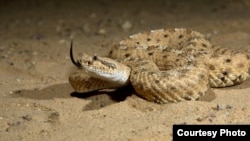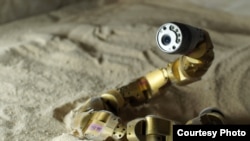In 2009, Spirit, one of NASA's two Mars rovers, got stuck in the sand. And more recently, the other rover - Curiosity - had to take a detour to avoid the shifting sands of the red planet.
This got some scientists to thinking about ways to keep our very expensive robotic probes from getting sidelined by something as inconsequential as a sand trap.
And they are taking their cues from Mother Nature.
In an experiment at Zoo Atlanta, deadly sidewinder rattlesnakes were put into a specially designed sandbox with adjustable inclines.
Scientists used high-speed video cameras to track the position of the snakes as they moved sideways up slopes of different grades, a movement called sidewinding. The snakes proved to be agile climbers even in shifting sand.
Daniel Goldman, an associate professor of physics at the George Institute of Technology, now knows how they did it.
Sidewinders don't sink in sand
Writing in the journal Science, he and colleagues from Georgia Tech, Zoo Atlanta and Carnegie Mellon University are the first to explain this serpentine movement. He says what they saw was, “as the incline angle increased, more of the snake’s body was on the ground.”
But that discovery wasn't the end of the experiment.
Next into the sand pit was MOD-Snake, a meter-long robot composed of 16 identical modules, each six centimeters in diameter. Goldman says the bot, developed at Carnegie Mellon University, has a long history of getting in and out of tight places.
"It turned out that they had actually been using the sidewinder gait in their robot for many years to traverses all kinds of ground, but always had trouble on sandy dune inclines," he said.
Robot programmed with new moves
Goldman says once researchers quantified the real snake's wave-like movement into programmable data, the next step was to get the robot to climb in the same way.
“And those same waves existed in the robot and allowed it to make its maneuvers and allowed us to modify those waves to make the kind of maneuvers that the snake did on sandy dunes of different inclines, that is laying down more robot as the hill angle increased,” he said.
The researchers ran the same experiment with other snakes closely related to the rattler, and they all failed miserably to sidewind up the inclines.
Zoo Atlanta research director Joe Mendelson says the robot model helped explain those failures.
“We found a really fascinating system where the snake informs what the robot can do, and then we can manipulate the robot to do the things that either the snake won’t do or can’t do," he said. "And so we have this self-informing system that has really opened up new parameters within snake biology and robotics.”
Snake-like robot future in tight places
Mendelson adds that the next generation of Mod-Snake may be deployed to save lives or explore remote regions on Earth or in space.
“Robots are expensive. And if a robot gets stuck in the sand that’s a problem, especially if that sand happens to be on one or another planet, or a very distant from an exploration post. And we realized going into this, that sidewinders never ever, ever get stuck on sand," he said.
The researchers hope the new sidewinder bot will navigate sand dunes just as well.

